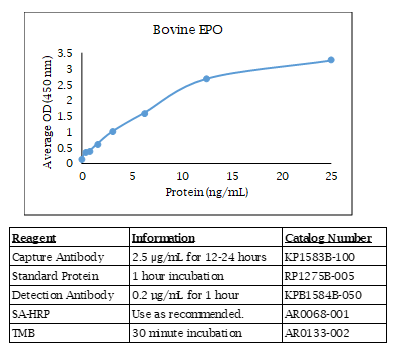Bovine Erythropoietin (EPO) Do-It-Yourself ELISA, ≤20 Plates
Bovine EPO ELISA Data

Bovine EPO ELISA Kit Components
| Component | Usage | Quantity | Catalog # |
| Anti-Bovine Erythropoietin Polyclonal Antibody | Capture Antibody | 100 µg X 2 | KP1583B-100 |
| Biotinylated Anti-Bovine Erythropoietin Polyclonal Antibody | Detection Antibody | 50 µg | KPB1584B-050 |
| Bovine Erythropoietin Recombinant Protein | Standard | 5 µg | RP1275B-005 |
Bovine EPO ELISA Specifications
The Bovine Erythropoietin Do-It-Yourself ELISA contains capture antibody, protein standard, and detection antibody for development of a Bovine EPO ELISA. The antibodies have been determined to function in an ELISA with the standard provided. Optimal buffers, concentrations, incubation times, incubation temperatures, and methods for the ELISA have not been determined. A working knowledge of ELISA is strongly recommended. The quantities of components provided are not matched. Components may also be purchased separately.
The Bovine Erythropoietin Do-It-Yourself ELISA can also be used to measure Bison, Yak, and Zebu Erythropoietin (EPO).
For additional tips and techniques to ensure a successful ELISA, check out our ELISA Technical Guide.
EPO Background
Erythropoietin (EPO) is an essential hormone for red blood cell production. Without it, definitive erythropoiesis does not take place. Erythropoietin has its primary effect on red blood cell progenitors and precursors by promoting their survival through protecting these cells from apoptosis. It is the primary erythropoietic factor that cooperates with various other growth factors (e.g., IL-3, IL-6, glucocorticoids, and SCF) involved in the development of erythroid lineage from multipotent progenitors. Erythropoietin has a range of actions including vasoconstriction-dependent hypertension, stimulating angiogenesis, and inducing proliferation of smooth muscle fibers. It can increase iron absorption by suppressing the hormone hepcidin. EPO is highly glycosylated, with half-life in blood around five hours. The half-life of EPO may vary between endogenous and various recombinant versions. Additional glycosylation or other alterations of EPO via recombinant technology have led to increased stability in blood. EPO binds to the erythropoietin receptor on the red cell progenitor surface and activates a JAK2 signaling cascade. Erythropoietin receptor expression is found in a number of tissues, such as bone marrow and peripheral/central nervous tissue. In the bloodstream, red cells themselves do not express erythropoietin receptor, so cannot respond to EPO. However, indirect dependence of red cell longevity in the blood on plasma erythropoietin levels has been reported, a process termed neocytolysis.
Alternate Names - EPO, EP, MVCD2, erythropoietin, Erythropoietin, ECYT5, DBAL
Ordering Information & Terms and Conditions
We require a phone number and e-mail address for both the end user of the ordered product and your institution's Accounts Payable representative. This information is only used to help with technical and billing issues.
Via Phone
Please call us at 651-646-0089 between the hours of 8:30 a.m. and 5:30 p.m. CST Mon - Fri.
Via Fax
Orders can be faxed to us 24 hours a day at 651-646-0095.
Via E-mail
Please e-mail orders to orders@KingfisherBiotech.com.
Via Mail
Please mail your order to:
Sales Order Entry
Kingfisher Biotech, Inc.
1000 Westgate Drive
Suite 123
Saint Paul, MN 55114
USA
Product Warranty
Kingfisher Biotech brand products are warranted by Kingfisher Biotech, Inc. to meet stated product specifications and to conform to label descriptions when used, handled and stored according to instructions. Unless otherwise stated, this warranty is limited to one year from date of sale. Kingfisher Biotech’s sole liability for the product is limited to replacement of the product or refund of the purchase price. Kingfisher Biotech brand products are supplied for research applications. They are not intended for medicinal, diagnostic or therapeutic use. The products may not be resold, modified for resale or used to manufacture commercial products without prior written approval from Kingfisher Biotech.
Payment Terms
All prices are subject to change without notice. Payment terms are net thirty (30) days from receipt of invoice. A 1.5% service charge per month is added for accounts past due over 30 days. Prices quoted are U.S. Dollars. The purchaser assumes responsibility for any applicable tax. You will only be charged for products shipped. Products placed on back order will be charged when shipped. If you place an order and fail to fulfill the terms of payment, Kingfisher Biotech, Inc. may without prejudice to any other lawful remedy defer further shipments and/or cancel any order. You shall be liable to Kingfisher Biotech, Inc. for all costs and fees, including attorneys' fees, which Kingfisher Biotech, Inc. may reasonably incur in any actions to collect on your overdue account. Kingfisher Biotech, Inc. does not agree to, and is not bound by, any other terms or conditions such as terms in a purchase order that have not been expressly agreed to in writing signed by a duly authorized officer of Kingfisher Biotech, Inc.
Shipping
Shipping and handling costs are prepaid and added to the invoice. Shipping and handling costs will be charged only on the first shipment in situations where an order contains back ordered products. Kingfisher Biotech, Inc. reserves the right to select the packaging and shipping method for your order, which will ensure the stability of the product and also efficient tracing. Domestic orders will normally be shipped by overnight. Damage during shipment is covered by the warranty provided in these terms and conditions. For international orders, title to the goods passes in the United States when the goods are placed with the shipper. For all orders, the risk of loss of the goods passes when the goods are placed with the shipper.
Returns
Please call customer service before returning any products for refund, credit or replacement. NO returns will be accepted without prior written authorization. Returns are subject to a restocking fee of 20%.



 New Products
New Products Ordering
Ordering Distributors
Distributors Resources
Resources FAQs
FAQs Cart
Cart